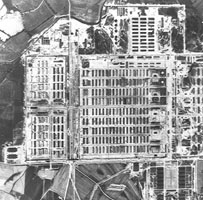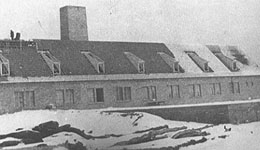
BIRKENAU -- KREMAS II, III, IV AND V

A detailed study of these Kremas resulted in the following information.
 Kremas
II and III were mirror image installations consisting of several morgues and a
crematory of 15 retorts each. The morgues were in the basement and the
crematories on the ground floor. An elevator was utilized for corpse transport
from the morgues to the crematory. The included drawings were generated from
original blueprints obtained at the Auschwitz State Museum and observations made
and measurements taken on location. Construction was of brick, mortar and
concrete.
Kremas
II and III were mirror image installations consisting of several morgues and a
crematory of 15 retorts each. The morgues were in the basement and the
crematories on the ground floor. An elevator was utilized for corpse transport
from the morgues to the crematory. The included drawings were generated from
original blueprints obtained at the Auschwitz State Museum and observations made
and measurements taken on location. Construction was of brick, mortar and
concrete.
The investigated areas were the alleged gas chambers designated as morgue #1 on both drawings. As noted for Krema I, there was no ventilation, no heating system, no circulation system, no sealant inside or out and further, no doors on the morgues in Krema II. The area has been examined by the author and no evidence of doors or door frames has been found. This investigator could not make this determination for Krema III since portions of the structure are missing. Both structures had roofs of reinforced concrete without any apparent openings. Further, reports of hollow gas-carrying columns are not true. All the columns are solid, reinforced concrete exactly as indicated in the captured German plans. The roof vents are not gasketed. These facilities would be very dangerous if used as gas chambers and this use would probably result in the death of the users and an explosion when the gas reached the crematory. Each facility had a corpse elevator of 2.1 meters x 1.35 meters. Clearly, this elevator was large enough for only one (1) body and an attendant.
The alleged gas chamber in each of Kremas II and III had an area of 2500 sq.
ft. This would accommodate 278 people based on the 9 square foot theory. If the
chamber were filled with the required HCN gas (0.25 lbs./1000 cu. ft.) and
assuming a ceiling height of 8 feet and 20,000 cubic feet of space, then 5 lbs.
of Zyklon B gas would be required. Again, assume at least one week to vent (as
at Krema I). This ventilation time is again doubtful, but will serve to compute
our numbers.
 Computed
usage rates for Kremas II and III (theoretical and real-time) and alleged
execution gas chamber at maximum capacity are set out in
Table V.
Computed
usage rates for Kremas II and III (theoretical and real-time) and alleged
execution gas chamber at maximum capacity are set out in
Table V.
Kremas IV and V were mirror image installations consisting of crematories of two
furnaces with 4 retorts each and numerous rooms utilized as mortuaries, offices
and storage. The interior rooms did not conform to the mirror image. Some of
these rooms were allegedly used as gas chambers. It is impossible the buildings
were razed long ago. No sealant was found anywhere on the foundation or floor.
According to reports, Zyklon B gas pellets were allegedly thrown through wall
ports which are now non-existent. if the plans of the building are correct,
these facilities likewise were not gas chambers, for the same reasons iterated
earlier for Kremas I, II, and III. Construction was apparently red brick and
mortar with a concrete floor and no basement. It should be noted that the
existence of cremation and execution facilities at Kremas IV and V is
unsubstantiated.
Based upon statistics, obtained from the Auschwitz State Museum and measurements made at the site, for Kremas IV and V relative to the alleged gas areas, and assuming a ceiling height of 8 feet, the computed statistics are as follows:
KREMA IV
1875 sq. ft.; will hold 209 people. 15,000 cu. ft. will use 3.75 lbs. of Zyklon B gas at 0.25 lbs./1000 cu. ft.
KREMA V
5125 sq. ft.; will hold 570 people. 41,000 cu. ft. will use 10.25 lbs. of Zyklon B gas at 0.25 lbs./1000 cu. ft.
Computed alleged usage rates for Kremas IV and V (theoretical and real-time) and gas chamber at maximum capacity and 1 week ventilation time are set out in Table VI

The Red and White houses, otherwise designated as Bunker I and II, were alleged to be gas chambers only, and there are no estimates available or statistics on the buildings.
http://www.zundelsite.org/leuchter/report1/birkenau.html